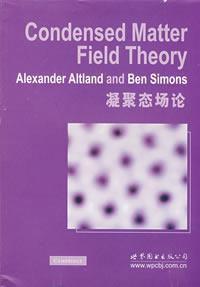內容介紹
Theoretical condensed matter physics draws heavily and increasingly on the language of quantum field theory. This primer is aimed at elevating graduate students of condensed matter physics to a level where they can engage in independent research. It emphasizes the development of modem methods of classical and quantum field theory with applications of interest in both experimental and theoretical condensed matter physics. Topics covered include second quantization, path and functional field integration, mean-field theory and collective phenomena, the renormalization group, and topology. Conceptual aspects and formal methodology are emphasized and developed, but the discussion is rooted firmly in practical experimental application. As well as routine exercises, the text includes extended and challenging problems, with fully worked solutions, designed to provide a bridge between formal manipulations and research-oriented thinking.
作品目錄
Preface
1 From particles to fields
1.1 Classical harmonic chain: phonons
1.2 Functional analysis and variational principles
1.3 Maxwell's equations as a variational principle
1.4 Quantum chain
1.5 Quantum electrodynamics
1.6 Noether's theorem
1.7 Summary and outlook
1.8 Problems
2 Second quantization
2.1 Introduction to second quantization
2.2 Applications of second quantization
2.3 Summary and outlook
2.4 Problems
3 Feymnan path integral
3.1 The path integral: general formalism
3.2 Construction of the path integral
3.3 Applications of the Feynman path integral
3.4 Summary and outlook
3.5 Problems
4 Functional field integral
4.1 Construction of the many-body path integral
4.2 Field integral for the quantum partition function
4.3 Field theoretical bosonization: a case study
4.4 Summary and outlook
4.5 Problems
5 Perturbation theory
5.1 General structures and low-order expansions
5.2 Ground state energy of the interacting electron gas
5.3 Infinite-order expansions
5.4 Summary and outlook
5.5 Problems
6 Broken symmetry and collective phenomena
6.1 Mean-field theory
6.2 Plasma theory of the interacting electron gas
6.3 Bose-Einstein condensation and superfluidity
6.4 Superconductivity
6.5 Field theory of the disordered electron gas
6.6 Summary and outlook
6.7 Problems
7 Response functions
7.1 Crash course in modem experimental techniques
7.2 Linear response theory
7.3 Analytic structure of correlation functions
7.4 Electromagnetic linear response
7.5 Summary and outlook
7.6 Problems
8 The renormalization group
8.1 The one-dimensional Ising model
8.2 Dissipative quantum tunneling
8.3 Renormalization group: generaltheory
8.4 RG analysis of the ferromagnetic transition
8.5 RG analysis of the nonlinear o'-model
8.6 Berezinskii-Kosterlitz-Thouless transition
8.7 Summary and outlook
8.8 Problems
9 Topology
9.1 Example: particle on a ring
9.2 Homotopy
9.3 θ-Terms
9.4 Wess-Zumino terms
9.5 Chern-Simons terms
9.6 Summary and outlook
9.7 Problems
Index

